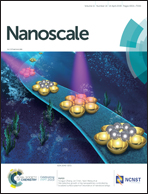Engineering fluorescence intensity and electron concentration of monolayer MoS2 by forming heterostructures with semiconductor dots†
Abstract
In this work, novel 2D/0D hybrid heterostructures with facilely adjustable fluorescence intensity and carrier concentration are achieved by decorating monolayer MoS2 (1L-MoS2) flakes with semiconductor-dots (carbon-dots or ZnO-dots). By carbon-dot decoration, the fluorescence intensity of 1L-MoS2 is significantly suppressed due to the n-type doping effect of electron transfer from carbon-dots to 1L-MoS2. In contrast, 1L-MoS2 decorated with ZnO-dots exhibits remarkably enhanced photoluminescence, because of the effective p-type doping modulation of electron transfer from 1L-MoS2 to ZnO-dots. The different charge transfer directions lie in the distinct energy band alignment of the two heterostructures. Raman, time-resolved photoluminescence and X-ray photoelectron spectroscopy studies prove the effective charge transfer between 1L-MoS2 and carbon-dots/ZnO-dots. Semi-quantitative estimations based on a mass-action-model demonstrate that the electron concentration in 1L-MoS2 can be controllably tuned from 1012 to 1014 cm−2via the p-type/n-type doping effect of these hybrid heterostructures.



 Please wait while we load your content...
Please wait while we load your content...